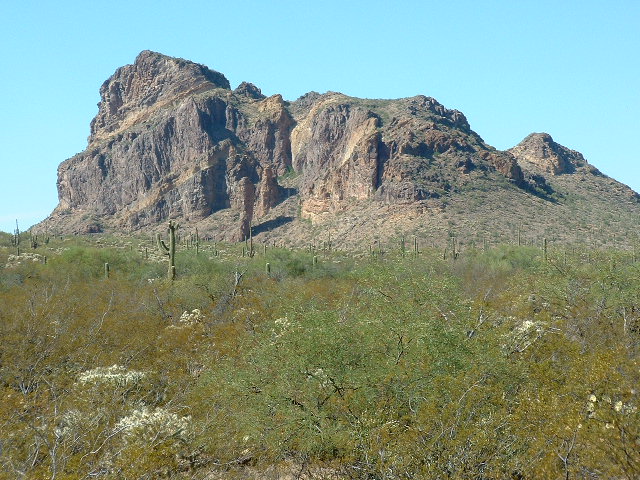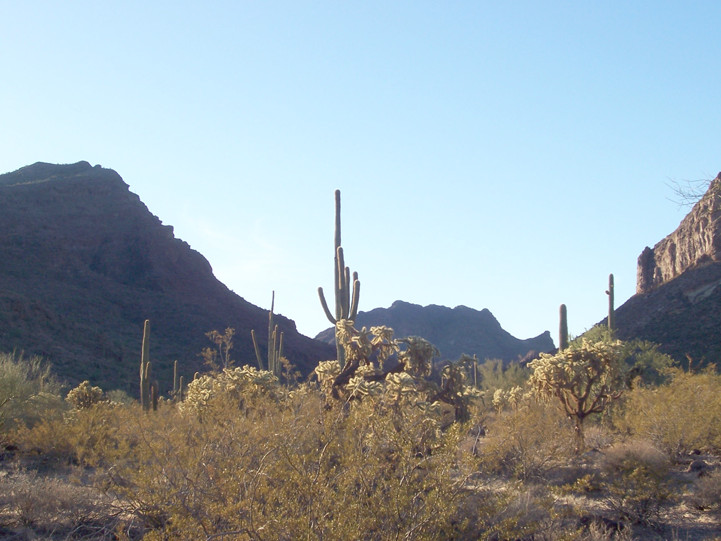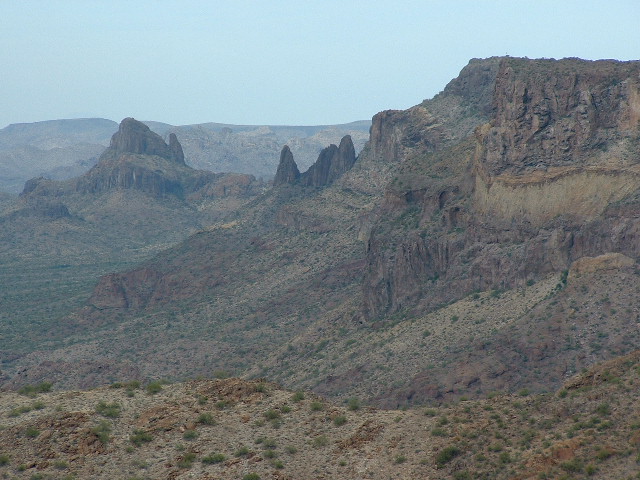January 2, 2010 started off in a normal-enough way. Normal, if you consider the intention to cover 20 miles on foot with almost 4,000 vertical feet of elevation gain in a very remote part of the Sonoran desert as normal. Climbers in this part of the world call that a death march. I’m not sure if the name suggests that you could die doing it, or that you are taking your life in your own hands by attempting it, or that it wouldn’t really surprise anyone if something really bad happened to you if you tried such a thing. Maybe it just means a really long hard day. Maybe it’s just the raw numbers – a lot of miles and elevation gain – coupled with doing it in a remote area far from any help if you got into trouble. Hard to say. In any case, Paul and I figured that this one would be a death march all right, and we were up for it.
We drove three hours from Tucson in Paul’s pickup and finally got to our parking place. It was still so early that it was pitch black. This is what it looked like when we started.
Our packs were pretty much ready from the night before, we just had to add as many quarts of liquid as we needed for the long day ahead of us. When I say liquid, I don’t mean water. Here in the desert, the air is so dry that even in cool weather you can easily become dehydrated by losing moisture through your skin and from normal breathing. We were carrying electrolyte replacement – any number of products will work fine. I think Paul was carrying Gatorade. For the rest of my life, I will always remember what I was drinking that day, a product called Zipfizz. But more on that later. We tried to hydrate as much as possible before starting out – Paul managed to drink two liters, I drank maybe one. Something worth mentioning here is that Paul had not slept a wink the night before setting out on this trip. He tends to be a night-owl anyway, but he was afraid of oversleeping and missing our Tucson rendezvous, so he simply stayed up all night so he could leave on time. He was already playing against a stacked deck before we started out.
We shouldered our day packs, which were pretty heavy. I was carrying five quarts, Paul had eight. That’s crazy – he had sixteen pounds of liquid, not counting the weight of the bottles! We turned on our headlamps and headed south into the night. I’m not mentioning the place we were going because it is ………. well, let’s just say it was in an area of the desert we were not really supposed to be. Our first obstacle was to cross a huge wash (for those of you not familiar with some of our desert terminology, a wash is a stream bed, dry nearly all of the time, but sometimes with running water in the rainy season). Even though this wash was bone-dry today, enough water runs in it at times to allow a lot of vegetation to grow and even thrive. And this one was thick with trees and brush of every description, forcing us to do some real bushwhacking. We weren’t cutting straight across it but at an angle, so that we had to travel almost half a mile before we left it behind. Every time we thought we were done with it, we would come to yet another dry sandy channel and another thick strand of nasty thorny brush. Paul accurately described the sand as “sugar-sand”, very fine and tiring to walk in. He kept fiddling with his headlamp, trying to adjust the beam, and had gone through much of the wash before he got it right.
By the time we got out of the wash, the day was beginning to dawn in the east, enough that we could turn off our headlamps. We now had to cross through about a mile and a half of low hills. While doing this, we saw a few faint footpaths which we followed for a while, as they seemed to be going in the direction we needed. This was stony ground, and the stones were of a size and number that you couldn’t avoid them, you had to step on them, and this was hard on our feet and ankles. Once through these hills, we dropped down into a major valley, where we found a very well-used trail which was obviously trodden by many feet on a regular basis. This didn’t surprise us too much, as we knew that this valley was a major conduit for undocumented aliens entering the country. We also saw what appeared to be ATV tracks, probably left by the Border Patrol, which were going in the direction we were heading.
Paul and I kept moving along at a pretty good clip – we couldn’t afford to slacken our pace too much because of the huge effort we still had to make before this climb was over. So the miles passed by. As we headed south, we were forced to drop down into and then climb back up out of gullies that were coming in from the long string of mountains that lined the west side of our valley. Each of these gullies was anywhere from fifteen to forty feet deep, and there were dozens of them. The scenery was spectacular and awe-inspiring. Unfortunately, the path we were following was littered with trash, the cast-offs of those who had passed by before us – day packs, water bottles, empty food cans, clothing of every type, toiletries, sunglasses, cigarette packages, footwear (running shoes, sandals, boots) – and the sheer volume of it was hard to believe. There was even a ruined ten-speed bicycle, certainly not designed for travel through this rugged terrain. We knew that a great many had passed here before us.
Up ahead, something caught our eye. As we approached it, we saw that it was a lot of yellow plastic caution tape, the kind that police will string up at a crime scene. It hung from trees and bushes, encompassing a large area. The only conclusion we could arrive at was that perhaps someone had died here and they had marked the area and done an investigation.
A few hours after we had started walking, it happened. Paul and I have had several conversations about this event since it happened, and here is our best reconstruction of the details.
We were walking along, minding our own business, when up ahead of us, maybe 300 feet away, we saw a man. He may have made some sound which first attracted our attention. He disappeared behind some vegetation, and by the time he re-appeared he was only about 100 feet away. He was heading north towards us and he appeared to be stumbling. He was alone. I called out to him three or four times before he noticed us. Paul immediately felt that we were in danger, that maybe there were other individuals hiding nearby. Something definitely didn’t seem right, and Paul stooped down to pick up a softball-sized rock.
This man had hispanic features, dirty black hair and a few days growth of beard. He was wearing a black hooded sweatshirt, jeans and tattered black sneakers, and he had no hat. We were only about ten feet away from him at this point. I assumed he spoke no English so I started conversing with him in Spanish. He said he had been with a group of border-crossers who had abandoned him two days earlier. Bad blisters had caused him to slow down and were the reason we had seen him limping. The group had taken his food and water and left him alone with nothing more than the clothes on his back, almost certainly a death sentence in this hostile land.
He said that the coyote, the human-smuggler guide who was leading his group, had told him that if he kept walking, he would reach the city of Phoenix in a day or so, that it was very close. One last big lie before leaving him to die. In actual fact, Phoenix was more than 100 miles distant. I told him that he had been lied to, that in his condition there was no human settlement he could reach, period. Mexico was closer than anyplace else, and he knew that he could never make it back there either.The poor guy started sobbing, tears streaming down his face, as the grim news sank in.
I reached into my pack and took out a quart of my precious electrolyte solution and gave it to him. We may also have given him something to eat, I don’t recall for sure. I explained to him that we were mountain climbers and were heading in the opposite direction to his line of travel. He was obviously very emotional, but we honestly thought that he didn’t look too bad otherwise. I then told him that if he continued on the very good footpath he was on, he would come to a road this very day. He should sit by the road and go no farther, that la migra (the Border Patrol) would come by soon and pick him up and take him to safety and his ordeal would be over. Taking out our map, I showed him clearly the path he was to follow. He seemed to understand the directions we gave him and said that he would do what we said. We told him that we would be back this way later in the day and would keep an eye out for him, that if we came upon him we would help him out to the road. He seemed more confident now that he was going to make it to safety and thanked us profusely. I asked him if he felt that he could make it out to the road okay by himself and he answered yes. We wished him well and reminded him again to follow our directions carefully and he would be okay.
He set off, continuing north, and Paul and I shouldered our packs and resumed our journey south. We looked back a few times to check on him but soon lost sight of him in the thick brush. At this point, we felt pretty confident that he would make it out to the road just fine. In spite of that, he remained a main topic of conversation for the rest of the day.
To be continued……………
Please visit our Facebook page at https://www.facebook.com/pages/Desert-Mountaineer/192730747542690




